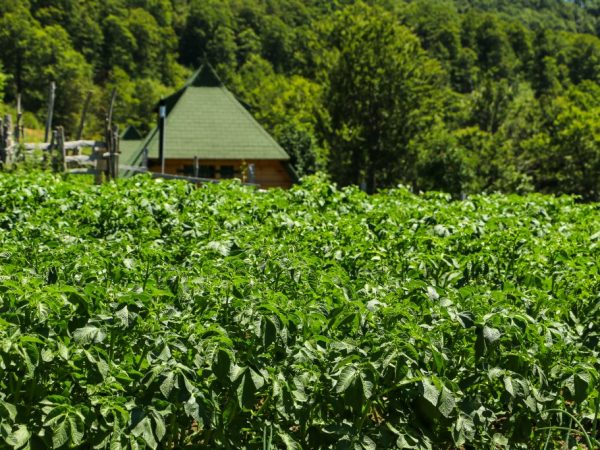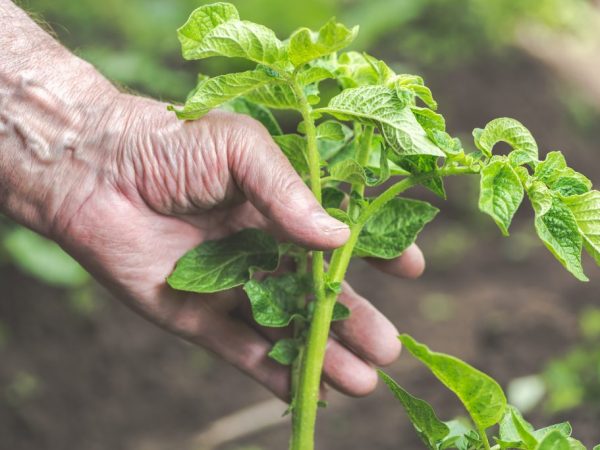Removing the tops from potatoes
Growing vegetables on their personal plot, gardeners follow the rules of agricultural technology. To get the maximum yield, you need to properly care for the plants, water, fertilize and fight weeds and harmful insects on time. When dealing with potatoes, you need to know why the potato tops are cut and whether it is necessary to do it. They also pay attention to the timing of harvesting the stems, which affect the yield of the crop, its quality and storage duration.

Removing the tops from potatoes
Why are the tops removed?
There are several reasons why it is recommended to remove the tops before harvesting. Consider why this is done, and what positive results the removal of greenery gives.
- After mowing the tops of the potatoes, the tubers ripen at an accelerated rate.
- The quality of the products is improved due to the supply of nutrients from the stems to the fruits.
- Rather, the soil between the rows dries out and the peel of the fruit coarsens.
- The risk of late blight disease in tubers is reduced to a minimum.
Young potatoes have a thin and delicate skin that is easily damaged during harvesting. To avoid damage, you need to dig out the tubers at the stage of technical ripeness.
If you cut the tops of potatoes, then the taste of the product will improve. The peel will begin to thicken, which will allow, when harvesting, to preserve the tubers as much as possible.
The soil, in the area with potato plantings, will not contaminate the fruits, stick to tools when digging products. This will keep the tubers from rotting. When it rains often, the tops should be cut a week or 2 weeks before harvesting.
Excessive moisture can encourage new shoots and leaves to sprout on the stems. They will begin to feed on the tubers, taking back all the vitamins and nutrients, deteriorating the quality of the fruit. This can give rise to fungal diseases and viruses. Such potatoes will be poorly stored and a large number of products will die.
How to properly trim the tops
The rules for mowing potato tops usually differ little in different regions and depend on weather conditions. Depending on the variety, the timing of cutting the aboveground part of the plants can be shifted in time. Mid-season varieties go through this procedure earlier than late varieties of potatoes. But in the latter case, it is important not to delay pruning so that the tubers have time to ripen before harvesting.
Things to Consider
According to the biology of tuberous plants, the formation of fruiting bodies begins before the budding phase. During flowering, tubers grow and develop intensively, accumulating nutrients and vitamins. The thin rind and starchiness are highly prized in young potatoes when cooked. If the potatoes are grown for sale in a young state, then the tops are not mowed.
When growing products for storage, cut the stems so that they remain at least 20 cm above the soil level.New leaves and branches will not be able to form on bare stems, and pesticides can be absorbed directly into the soil.
You can carry out the process of cutting the aerial part of the plants in 2 stages. First, we cut off the tops of all the potatoes in the upper part, with the bulk of the leaves. After a week, you need to carry out the final cleaning of the greenery.
If the bushes have died from the severity of leaves or frequent rains, then the aboveground part is removed to a height of about 15 cm. It is not recommended to completely remove the stems to the level of the soil. this can interfere with harvesting, when visually determining the location of the fruit nests of potatoes.
When to cut the tops

Ripening of tubers can be accelerated
During the period of budding and flowering, it is necessary to fertilize the plantings. Fungicide treatment is carried out a week before mowing the stems, when the berries begin to form after pollination of the flowers. Once the greens are removed, the chemicals can protect the tubers from viruses.
The optimal pruning time is considered to be the time when at least a month has passed after flowering and the bulk of the fruits is still growing. Then the tubers were fully formed, they accumulated a sufficient amount of starch, mineral and organic substances.
The main indicator for trimming the aboveground part of plants is yellowing of more than 50% of the stems. These conditions can change if potatoes are grown in the regions of the North and Siberia, where frequent and early frosts are possible. Why risk your harvest when you can speed up tuber ripening and harvesting.
Cutting when the leaves are affected
A month before frost, it is necessary to cut the tops. Within 2 weeks, the tubers will mature and be suitable for harvesting. The hardened peel, when harvested, will be resistant to damage. Cuts and scrapes resulting from contact with tools and industrial cleaning equipment will heal and dry for another 2 weeks.
An exception to the rules for removing the aerial part of plants may be the threat of late blight. Then emergency measures are taken to save the harvest.
- If the leaves are affected, it is urgent to remove the tops.
- One cannot wait for the time when cold nights come and fog and dew appear in the morning.
- Greens with signs of disease must be burned.
All measures for the prevention of late blight are carried out to preserve the harvest and keep the fruits well during storage.
To accelerate the ripening of fruits, superphosphate is used. If a simple preparation is available, then take 300 g per 10 liters of water, and double superphosphate is prepared: 150 g of a chemical per 10 liters. This amount is enough for one hundred square meters. After processing, the weight of the fruits increases and it is possible to increase the yield by 1.5 kg from 1 m2. A week after treatment with superphosphate, you can mow the plantings with a trimmer or manually.
Using cut tops
Healthy leaves and stems can be preserved for future use. The next year, the dried green mass is used as mulch for planting various crops. Shrubs are especially often mulched, such as:
- raspberries;
- currant;
- gooseberry;
- barberry;
- felt cherry.
Moisture is retained under the bed of potato mulch and the soil does not overheat.
A good effect is given by spraying plants with an infusion of fresh or dry herbs, from aphids, cicadas and ticks. For 1.5 kg of fresh mass or 800 g of dry, take 10 liters of boiling water. After cooling for 1 hour, add 40 g of laundry soap to the solution and process the planting. It is advisable to add a little more water, so as not to burn the plants, with an increased concentration of organic matter in the solution.
Conclusion
Considering the rules for caring for potato plantings, sometimes they ignore the cutting of the tops. But this is a very important element that allows you to preserve the harvest, improve the quality of tubers and protect against diseases. By removing the green mass, gardeners not only increase yields, but also allow the potatoes to prepare for long-term storage.Healthy tubers left for seed will produce strong plants next year that can withstand attacks from pests and viral diseases.


